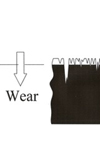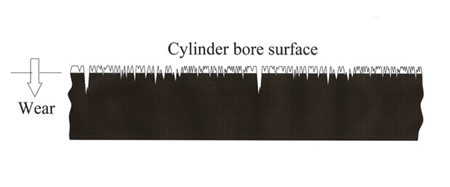Liner wear
 As in all mechanical systems when adjacent parts in contact move relative to each other, wear will inevitably take place. Even in the best designs, lubrication only serves to delay the onset of damage, and failure of one form or another will always occur. The interface between piston/piston ring and the cylinder bore is a perfect example.
As in all mechanical systems when adjacent parts in contact move relative to each other, wear will inevitably take place. Even in the best designs, lubrication only serves to delay the onset of damage, and failure of one form or another will always occur. The interface between piston/piston ring and the cylinder bore is a perfect example.
In reviewing wear therefore it is perhaps necessary to distinguish between what might be termed normal and abnormal events. Abnormal wear might be considered the result of a foreign component, a piece of grit for instance, ingested into the cylinder and trapped between piston and bore, scoring the liner. Contact between piston ring top land and the bore would also, I maintain, be classified thus. Normal wear, however, the subject I intend (briefly) to discuss here, is inevitable and can only ever be minimised, never eliminated. The most obvious case for the piston ring and bore is the wear manifesting itself at the top ring reversal point.
For older readers, the 'step' in the bore at the highest point of the top ring travel will have been a familiar sight in some slightly higher mileage (usually gasoline) engines. Most noticeable on the thrust side of the cylinder, the combination of high combustion loads and lack of relative movement between piston ring and bore causes the 'wedge' of oil generated in the lubricant to break down, allowing metal-to-metal contact and subsequent wear.

It's much less of an issue these days, as improvements to cylinder surface finish and lubricant technology have mitigated the problem such that engines now can expect to reach 150,000 miles and more without any deterioration in performance. Boundary layer additives, such as esters, in early lubricant formulations gave way to more effective ZDDPs (zinc dithiophosphates), which for many years have provided a cheap and highly effective source of anti-wear chemistry. Working by way of polar attraction to metal surfaces, this is still the most popular anti-wear chemistry used in competition oils where engine exhaust catalysts are not used. In catalyst-equipped vehicles where limits to sulphur and phosphorus in engine oil exist, ZDDPs are steadily being replaced by other proprietary anti-wear chemistries.
Another form of cylinder bore wear not generally seen but which may be more apparent in future years is that of 'bore polish'. An issue more associated with highly pressure-charged diesel engines or engines where cylinder distortion is apparent, in the former, bore polish is a result of the combustion deposits becoming trapped around the piston ring assemblies and then acting as a mild abrasive, steadily wearing away the top layer of the cylinder surface. With each successive pass, the carefully crafted honing marks containing the lubricant are progressively 'machined' away to produce a polished-type surface, which is often hard to see, even to the most experienced of viewers. And as the cylinder wears the amount of oil trapped in the peaks and valleys of the surface finish, even further bore wear results.
In diesel applications the remedy is down to the dispersant in the oil and how it interacts with the detergents to prevent these soot deposits from coalescing and becoming rather similar to a grinding paste. This is why diesel engine oils tend to have much higher levels of detergents and dispersants over those of oils intended only for gasoline engines.
Although bore wear is rarely directly associated with the choice of lubricant, it is often as well to be reminded of the role it actually takes in preserving your engine.
Fig. 1 - As the peaks and valleys of the liner honing are worn away, a shiny polished patch remains
Written by John Coxon